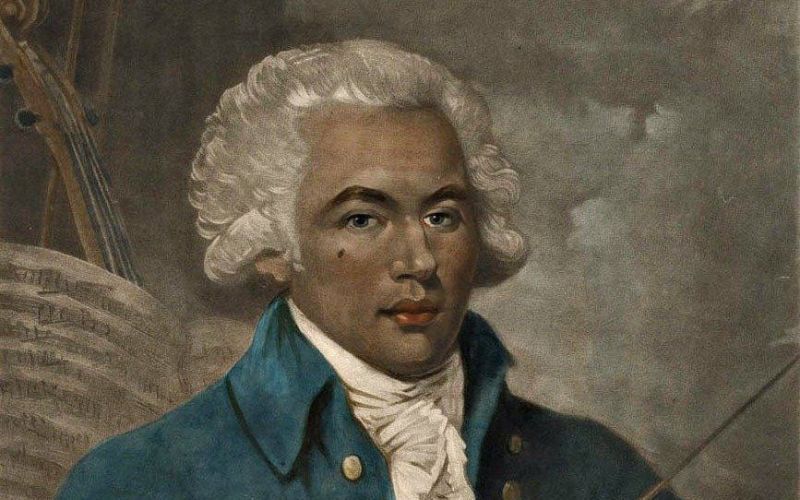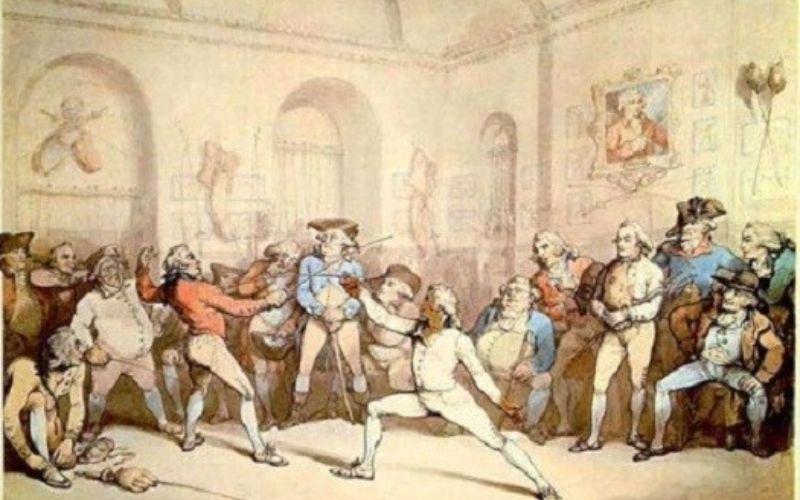The Chevalier de Saint-Georges, known as Joseph Bologne, left an indelible mark on history as a renowned composer, distinguished fencing master and extraordinary personality. This article explores the life, achievements and legacy of the Chevalier de Saint-Georges, highlighting his musical talents and mastery of the art of fencing.

Childhood and early beginnings:
Le Chevalier de Saint-Georges was born into an influential family in Baillif, Guadeloupe, around 1745. His mother, Nanon, was a freed slave, while his father, George Bologne de Saint-Georges, was a French aristocrat. Despite his mixed origins, Joseph Bologne benefited from a refined upbringing and showed precocious musical talent from childhood.
a. Joseph Bologne’s origins:
Joseph Bologne, known as Chevalier de Saint-Georges, was born around 1745 in Baillif, Guadeloupe. His origins are marked by a fascinating cultural mix. His mother, Nanon, was a freed slave of Guadeloupean origin, while his father, George Bologne de Saint-Georges, was a French aristocrat from a noble Guadeloupean family. This dual ancestry played a significant role in Joseph Bologne’s life, giving him a unique perspective on society and music.
b. His father’s influence:
George Bologne de Saint-Georges, Joseph’s father, played an important role in his upbringing and development. As a nobleman and landowner in Guadeloupe, George ensured that Joseph received a quality education and enjoyed privileges to which few people of mixed race had access at the time. He supported Joseph’s musical talents and encouraged him to perfect his art.
c. Early musical talent:
From an early age, Joseph Bologne demonstrated extraordinary musical talent. He began learning the violin and harpsichord as a child, showing a natural aptitude for music. His mother, Nanon, also played a key role in passing on traditional Guadeloupean tunes to him, imbuing his music with rich and varied cultural influences. His precocious talent soon attracted the attention of those around him, who recognized in him a future musical prodigy.
An extraordinary musical career:
At the age of 13, Saint-Georges moved to Paris to pursue his musical training. He studied violin with the famous master Leclair and quickly distinguished himself as an exceptional virtuoso. His original compositions, including symphonies, concertos and string quartets, brought him increasing recognition and success in Parisian musical circles.
a. Musical training in Paris:
After leaving Guadeloupe, Joseph Bologne moved to Paris to pursue his musical training. The city was the cultural and artistic center of the time, offering many opportunities for learning. Joseph studied violin with Jean-Marie Leclair, a famous master renowned for his virtuosity and expertise. Under Leclair’s tutelage, Joseph perfected his technique, refined his playing and developed a deep understanding of music.
b. Saint-Georges’ beginnings as a composer:
Beyond his talent as a performer, Joseph Bologne ventured into the field of composition. He began creating his own musical works, exploring various genres such as symphonies, concertos and string quartets. His early compositions already demonstrate exceptional technical mastery and musical sensitivity. Saint-Georges quickly made a name for himself in Parisian musical circles, attracting the attention of critics and music lovers alike.

The Chevalier’s musical virtuosity:
Saint-Georges was not only an accomplished composer, but also a master violinist. His impeccable technique, expressive musicality and ability to improvise earned him considerable renown. His compositions are imbued with dynamism, emotion and haunting melodies, reflecting the influence of the Baroque and Classical styles of the time.
a. Violin mastery:
Joseph Bologne’s training with Jean-Marie Leclair laid the foundations for his exceptional mastery of the violin. Through years of relentless practice and musical exploration, Saint-Georges became one of the most accomplished virtuosos of his time. His impeccable technique, precision of intonation and ability to convey deep emotion through his playing made him a true reference in the violin world. His technical mastery was such that he was able to improvise with ease, adding a unique dimension to his performances.
b. Saint-Georges’ famous compositions:
Saint-Georges’ compositions captivated listeners of his time and continue to be admired today. His most famous works include symphonies, concertos and string quartets. He combined the Baroque and Classical influences of the time to create innovative and captivating music. His expressive musical language, haunting melodies and mastery of musical form made his compositions works of great beauty. Among his best-known compositions is the Violin Concerto in D major, Op. 3, No. 1, which showcases his virtuosity and artistic sensitivity.

A skilled fencer:
Alongside his musical career, Saint-Georges also distinguished himself as a fencing master. He learned the art of fencing at an early age and quickly became one of the finest fencers of his day. His elegant technique, rapid execution and mastery of various weapons earned him renown both in France and abroad.
a. Learning the art of fencing:
In addition to his passion for music, the Chevalier de Saint-Georges also distinguished himself in the art of fencing. He began his apprenticeship as soon as he arrived in Paris, where he was trained by renowned masters. Inspired by his father, who was himself a fine fencer, Joseph developed a remarkable skill with the sword. His rigorous training and unfailing determination enabled him to become a formidable fencer, mastering the complex techniques and elegant movements of this martial art.
b. Growing renown :
Thanks to his exceptional talents in music and fencing, the Chevalier de Saint-Georges quickly gained a growing reputation. His impressive musical performances and captivating fencing duels attracted the attention of Parisian high society and artistic circles of the time. He became a popular guest at salons and concerts, where he charmed audiences with his musical virtuosity and charismatic presence.
c. The Chevalier’s legendary duels :
Le Chevalier de Saint-Georges took part in many legendary duels during his lifetime. His skill and dexterity with the sword were widely known, and prompted many challenges from other talented fencers. Among his most famous duels were with such formidable opponents as Chevalier d’Éon, another renowned fencing master. These exciting duels captured the public’s attention and helped forge Chevalier de Saint-Georges’ reputation as an exceptional fencer.
Saint-Georges as an influential figure:
In addition to his artistic talents, Saint-Georges was a man of influence in 18ᵉ century Parisian society. He was a member of aristocratic circles, frequented the salons of the nobility and was admired for his charisma and charm. He was also involved in politics and served in the French army, becoming the leader of the Saint-Georges volunteer regiment, composed mainly of men of color.
a. Social life and aristocratic circles:
The Chevalier de Saint-Georges’ social life was closely linked to the aristocratic circles of his day. Because of his musical talents, charisma and noble ancestry, he was well received in the Parisian salons of high society. He rubbed shoulders with influential figures, renowned artists and intellectuals, forging links with some of the most brilliant minds of his time. His presence in these circles provided him with support and resources for his artistic and musical projects.
b. Involvement in politics and the military :
Le Chevalier de Saint-Georges was not only an outstanding musician and fencer, he was also involved in politics and the army. As a fervent defender of the ideals of the French Revolution, he joined the ranks of the revolutionary army and rose through the ranks to become a colonel. His courage on the battlefield and inspirational leadership earned him the respect of his soldiers and superiors alike. Alongside his military commitment, he was also an active participant in the political debates of the day, defending the rights of people of color and advocating equality.
c. Enduring legacy and influence:
The Chevalier de Saint-Georges’ legacy endures to the present day. His contribution to classical music as a composer and violin virtuoso is recognized as remarkable. He paved the way for many black and mixed-race musicians, breaking down the racial and socially constructed barriers of the time. His influence is felt in music, art and society, underlining the importance of diversity and inclusion. Le Chevalier de Saint-Georges is an emblematic figure whose legacy transcends borders and continues to inspire future generations.
Conclusion:
Le Chevalier de Saint-Georges remains an iconic figure of the 18ᵉ century, whose musical talents and fencing skills continue to inspire today’s generations. His captivating music and mastery of the art of fencing have left a lasting legacy. As an influential figure of his time, Saint-Georges challenged the racial and social prejudices of the day, paving the way for future generations of artists and athletes. His impact on classical music and his role in the history of fencing are undeniable.
FAQ:
What musical genres has Saint-Georges contributed to?
Saint-Georges has contributed to musical genres such as symphonic music, concertos and string quartets, influenced by Baroque and Classical styles.
What are some of the Chevalier de Saint-Georges’ most famous duels?
The Chevalier de Saint-Georges took part in many memorable duels, including some with famous adversaries such as Chevalier d’Eon.
What is Saint-Georges’ best-known composition?
One of his best-known compositions is the Violin Concerto in D major, Op. 3, No. 1, which showcases his virtuosity on the violin.
How did the Chevalier de Saint-Georges influence classical music?
Saint-Georges contributed to the evolution of classical music by introducing innovative elements into his compositions and inspiring other composers of his time.
What is Saint-Georges’ lasting legacy to music history?
Saint-Georges’ legacy lies in his pioneering role as a composer and virtuoso violinist, breaking down racial barriers and serving as a source of inspiration for future generations of artists.
See also our article: Yasuke: The fascinating story of the first black samurai










